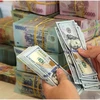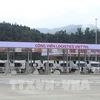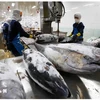Vietnam has recorded achievements and progress in boosting up industrialisation and modernisation after 25 years of pursuing the “Doi moi” (renewal) cause. The Vietnam Government Portal reports.
Escaping from slackness, recession
In the first period from 1986-1990, the nation’s gross domestic product (GDP) grew 4.4 percent per year. Growth rate of agricultural and industrial production averaged 3.8-4 percent per year and 7.4 percent per year, respectively.
In this period, Vietnam’s export turnover increased 28 percent per year. These successes were attributed to the implementation of target programmes on food, products and exports. The country succeeded in developing the economy and curbing inflation.
The nation continued its success through to the subsequent period from 1990-1995. Annual average GDP was 8.2 percent. Agriculture and industry enjoyed annual growth rates of 4.5% and 13.3 percent, respectively. The services sector expanded 12 percent per year. Total food produced in the five years from 1991-1995 was 125.4 million tons, up 27 percent compared to the 1986-1990 period.
Crucial economic developments
Between 1995 and 2000, the nation’s average GDP was estimated at 7 percent, with the growth rate in the agriculture-forestry-aquaculture sector being 4.1 percent; the industry and construction sector, 10.5 percent; and the services sector, 5.2 percent. GDP in 2000 doubled the 1990 figure.
After the socio-economic development strategy for 2001-2010 and the 2001-2005 five- year plan were launched, GDP rose 7.5 percent on average annually. The agricultural, industrial, construction and service sectors saw their growth rates increasing by 3.8 percent, 10.2 percent and 7 percent, respectively.
Total GDP in 2005 reached 837.8 trillion VND, doubling the figure in 1995. Per capita GDP was 640 USD.
Once importing around 50,000 to 1 million tonnes of food a year, Vietnam became the second largest exporter of rice, coffee and cashew in 2005.
The economic growth rate in 2005-2010 maintained at 7 percent a year. Total FDI was 45 billion USD, exceeding 77 percent of the plan. Newly-registered and added capital totalled 150 billion USD, 2.7 times higher than the plan and seven times higher than the 2001-2005 period.
Total ODA committed for Vietnam surpassed 31 billion USD, 1.5 times higher than the plan and ODA disbursement was 13.8 billion USD, up 16 percent. GDP in 2010 valued at 101.6 billion USD, 3.26 times higher than 2000's and GDP per capita was 1.168 USD.
At the Consultative Group Meeting of Donor for Vietnam held in December 2010, Minister of Planning and Investment Vo Hong Phuc stressed that Vietnam has shifted from a low-income country to a middle-income country.
Overcoming obstacles of global economic crisis
According to the International Monetary Fund (IMF), the global economic growth only stood at 4 percent in 2011 while Vietnamese economy expanded 5.89 percent, which was evaluated as higher than other nations in the region.
Over 20 years from 1991-2011, the nation’s GDP growth rate reached 7.34 percent per year with the economic scale in 2011 quadruplicated that in 1990 and 2.1 times greater than in 2000.
In 2012, GDP attained 155.3 billion USD, up 5.03 percent. Agriculture-forestry-aquaculture production inched up by 3.4 percent and industrial production rose 4.8 percent.
Vietnam gained 100 billion USD for export turnover, up 18.3 percent.
As of October 25, 2012, Vietnam exported 6 million tons of rice, becoming the largest rice exporter in the world.
From 1988 to July 2012, total registered FDI was estimated at 236 billion USD, of which more than 96.6 billion USD were disbursed.
Between 1993 and 2012, total ODA commitment and disbursement were 80 billion USD and 35 billion USD, respectively.-VNA
Escaping from slackness, recession
In the first period from 1986-1990, the nation’s gross domestic product (GDP) grew 4.4 percent per year. Growth rate of agricultural and industrial production averaged 3.8-4 percent per year and 7.4 percent per year, respectively.
In this period, Vietnam’s export turnover increased 28 percent per year. These successes were attributed to the implementation of target programmes on food, products and exports. The country succeeded in developing the economy and curbing inflation.
The nation continued its success through to the subsequent period from 1990-1995. Annual average GDP was 8.2 percent. Agriculture and industry enjoyed annual growth rates of 4.5% and 13.3 percent, respectively. The services sector expanded 12 percent per year. Total food produced in the five years from 1991-1995 was 125.4 million tons, up 27 percent compared to the 1986-1990 period.
Crucial economic developments
Between 1995 and 2000, the nation’s average GDP was estimated at 7 percent, with the growth rate in the agriculture-forestry-aquaculture sector being 4.1 percent; the industry and construction sector, 10.5 percent; and the services sector, 5.2 percent. GDP in 2000 doubled the 1990 figure.
After the socio-economic development strategy for 2001-2010 and the 2001-2005 five- year plan were launched, GDP rose 7.5 percent on average annually. The agricultural, industrial, construction and service sectors saw their growth rates increasing by 3.8 percent, 10.2 percent and 7 percent, respectively.
Total GDP in 2005 reached 837.8 trillion VND, doubling the figure in 1995. Per capita GDP was 640 USD.
Once importing around 50,000 to 1 million tonnes of food a year, Vietnam became the second largest exporter of rice, coffee and cashew in 2005.
The economic growth rate in 2005-2010 maintained at 7 percent a year. Total FDI was 45 billion USD, exceeding 77 percent of the plan. Newly-registered and added capital totalled 150 billion USD, 2.7 times higher than the plan and seven times higher than the 2001-2005 period.
Total ODA committed for Vietnam surpassed 31 billion USD, 1.5 times higher than the plan and ODA disbursement was 13.8 billion USD, up 16 percent. GDP in 2010 valued at 101.6 billion USD, 3.26 times higher than 2000's and GDP per capita was 1.168 USD.
At the Consultative Group Meeting of Donor for Vietnam held in December 2010, Minister of Planning and Investment Vo Hong Phuc stressed that Vietnam has shifted from a low-income country to a middle-income country.
Overcoming obstacles of global economic crisis
According to the International Monetary Fund (IMF), the global economic growth only stood at 4 percent in 2011 while Vietnamese economy expanded 5.89 percent, which was evaluated as higher than other nations in the region.
Over 20 years from 1991-2011, the nation’s GDP growth rate reached 7.34 percent per year with the economic scale in 2011 quadruplicated that in 1990 and 2.1 times greater than in 2000.
In 2012, GDP attained 155.3 billion USD, up 5.03 percent. Agriculture-forestry-aquaculture production inched up by 3.4 percent and industrial production rose 4.8 percent.
Vietnam gained 100 billion USD for export turnover, up 18.3 percent.
As of October 25, 2012, Vietnam exported 6 million tons of rice, becoming the largest rice exporter in the world.
From 1988 to July 2012, total registered FDI was estimated at 236 billion USD, of which more than 96.6 billion USD were disbursed.
Between 1993 and 2012, total ODA commitment and disbursement were 80 billion USD and 35 billion USD, respectively.-VNA



















